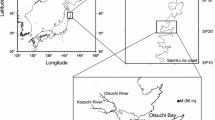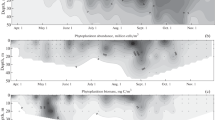Abstract
Sendai Bay is located on the Pacific coast of northern Japan and suffered serious damage following the 2011 off the Pacific coast of Tohoku earthquake and tsunami in March 2011. To assess the impact on the marine ecosystem, information was needed on the phytoplankton communities and their seasonal variation. However, such information was limited. Therefore, an intensive monitoring of the phytoplankton was carried out from March 2012 to April 2014. Seasonal variation of the phytoplankton community was similar at coastal and offshore stations. Total phytoplankton biomass, based on Chl a concentration, peaked in spring and then decreased to a minimum in summer, before gradually increasing during early winter and peaking again in the following spring. This seasonal pattern was consistent with previous studies conducted before the earthquake and tsunami. Also, size structure of the phytoplankton community and its four main groups was estimated from the size-fractioned samples of Chl a. Our results also showed that the spring bloom consisted of large diatoms, with their growth ceasing due to nitrogen depletion. The bloom was followed by a summer period where cyanobacteria and picoeukaryote became dominant, with high cell densities in spite of low nutrient concentrations. In addition, sporadic environmental changes, such as those following typhoons, were observed. These resulted in large increases/decreases in individual phytoplankton groups.





Similar content being viewed by others
References
Agawin NSR, Duarte CM, Agustí S (1998) Growth and abundance of Synechococcus sp. in a Mediterranean Bay: seasonality and relationship with temperature. Mar Ecol Prog Ser 170:45–53
Davis JJ, Foster RF (1958) Bioaccumulation of radioisotopes through aquatic food chains. Ecology 39(3):530–535
Falkowski PG, Raven JA (1997) Aquatic photosynthesis. Blackwell Science, Malden
Fukuda H, Katayama R, Yang Y, Takasu H, Nishibe Y, Tsuda A, Nagata T (2015) Nutrient status of Otsuchi Bay (northeastern Japan) following the 2011 off the Pacific coast of Tohoku earthquake. J Oceanogr. doi:10.1007/s10872-015-0296-2
Furuya K, Takahashi K, Iizumi H (1993) Wind-dependent formation of phytoplankton spring bloom in Otsuchi Bay, a ria in Sanriku, Japan. J Oceanogr 49(4):459–475
Kaeriyama H, Ambe D, Shimizu Y, Fujimoto K, Ono T, Yonezaki S, Kato Y, Matsunaga H, Minami H, Nakatsuka S, Watanabe T (2013) Direct observation of 134Cs and 137Cs in the western and central North Pacific after the Fukushima Dai-ichi nuclear power plant accident. Biogeosci 10(6):4287–4295
Kakehi S, Ito S, Yagi H, Wagawa T (2012) Estimation of the residence time of fresh and brackish water in Sendai Bay. J Japan Soc Civil Eng B Hydraul Coast Environ Eng 68(2):951–955 (in Japanese with English abstract)
Kakehi S, Ito S, Kuwata A, Saito H, Tadokoro K (2015) Phytoplankton distribution during the winter convective season in Sendai Bay, Japan. Cont Shelf Res 97:43–53
Kamiyama T, Yamauchi H, Nagai S, Yamaguchi M (2014) Differences in abundance and distribution of Alexandrium cysts in Sendai Bay, northern Japan, before and after the tsunami caused by the Great East Japan earthquake. J Oceanogr 70(2):185–195
Kudo H (1971) On the inflow of the open sea water to the Sendai Bay. Interim report of the studies on the Sendai Bay for J. IBP PM 4:9–26 (in Japanese with English abstract)
Kudo I, Yoshimura T, Yanada M, Matsunaga K (2000) Exhaustion of nitrate terminates a phytoplankton bloom in Funka Bay, Japan: change in SiO4:nO3 consumption rate during the bloom. Mar Ecol Prog Ser 193(1):45–51
Lee CW, Kudo I, Yanada M, Maita Y (2001) Bacterial abundance and production and their relation to primary production in Funka Bay. Plankton Biol Ecol 48(1):1–9
Moore LR, Goericke R, Chisholm SW (1995) Comparative physiology of Synechococcus and Prochlorococcus: influence of light and temperature on growth, pigments, fluorescence and absorptive properties. Mar Ecol Prog Ser 116:259–275
Nagasawa T, Tanaka H (2012) Analysis of structural damages with massive geomorphic change due to tsunami. J Japan Soc Civil Eng Ser B2 Coast Eng 68:1361–1365
Natsuike M, Kanamori M, Baba K, Moribe K, Yamaguchi A, Imai I (2014) Changes in abundances of Alexandrium tamarense resting cysts after the tsunami caused by the Great East Japan earthquake in Funka Bay, Hokkaido, Japan. Harmful Algae 39:271–279
R Core Team (2013) R: a language and environment for statistical computing. R Foundation for Statistical Computing, Vienna, Austria. http://www.R-project.org/. Accessed 11 Aug 2015
Sanders RW, Berninger U, Lim EL, Kemp PF, Caron DA (2000) Heterotrophic and mixotrophic nanoplankton predation on picoplankton in the Sargasso Sea and on Georges Bank. Mar Ecol Prog Ser 192:103–118
Sarangi RK (2012) Impact assessment of the Japanese tsunami on ocean-surface chlorophyll concentration using MODIS-Aqua data. J Appl Remote Sens 6(1):063539
Seike K, Shirai K, Kogure Y (2013) Disturbance of shallow marine soft-bottom environments and megabenthos assemblages by a huge tsunami induced by the 2011 M9.0 Tohoku-Oki earthquake. PLoS One 8(6):e65417
Siswanto E, Hashim M (2012) A data fusion study on the impacts of the 2011 Japan tsunami on the marine environment of Sendai Bay. Int J Image Data Fus 3(2):191–198
Strickland JD, Parsons TR (1972) A practical hand- book of seawater analysis. Bull Fish Res Bd Can 167:1–311
Suzuki R, Ishimaru T (1990) An improved method for the determination of phytoplankton chlorophyll using N, N-dimethylformamide. J Oceanogr 46(4):190–194
Suzuki K, Hinuma A, Saito H, Kiyosawa H, Liu H, Saino T, Tsuda A (2005) Responses of phytoplankton and heterotrophic bacteria in the northwest subarctic Pacific to in situ iron fertilization as estimated by HPLC pigment analysis and flow cytometry. Prog Oceanogr 64(2–4):167–187
Sverdrup HU (1953) On conditions for the vernal blooming of phytoplankton. J Cons Explor Mer 18:287–295
Tachibana A, Nishibe Y, Fukuda H, Kawanobe K, Tsuda A (2015) Phytoplankton community structure in Otsuchi Bay, northern Japan after the 2011 off the Pacific coast of Tohoku earthquake and tsunami. J Oceanogr (submitted)
Taguchi S, Satake T, Seki T (1989) Investigation of abundance of phytoplankton (IV)—Seasonal and vertical distribution of phytoplankton in Sendai Bay. Reports of Sendai Municipal Institute of Public Health 18:351–370
Taguchi S, Hiroshima K, Seki T (1990) Investigation of abundance of phytoplankton (V)—seasonal and vertical distribution of phytoplankton in Sendai Bay. Reports of Sendai Municipal Institute of Public Health 19:369–389
Takami H, Won NI, Kawamura T (2013) Impacts of the 2011 mega-earthquake and tsunami on abalone Haliotis discus hannai and sea urchin Strongylocentrotus nudus populations at Oshika Peninsula, Miyagi, Japan. Fish Oceanogr 22(2):113–120
Tomas CR (1997) Identifying marine phytoplankton. Academic, San Diego
Tsuchiya K, Yoshiki T, Nakajima R, Miyaguchi H, Kuwahara VS, Taguchi S, Kikuchi T, Toda T (2013) Typhoon-driven variations in primary production and phytoplankton assemblages in Sagami Bay, Japan: a case study of typhoon Mawar (T0511). Plankton Benthos Res 8(2):74–87
Urabe J, Suzuki T, Nishita T, Makino W (2013) Immediate ecological impacts of the 2011 Tohoku earthquake tsunami on intertidal flat communities. PLoS One 8(5):e62779
Watanabe T, Taniuchi Y, Kakehi S, Sakami T, Kuwata A (2015) Species composition and seasonal succession of diatoms in Sendai Bay, northern Japan. J Oceanogr (submitted)
Welschmeyer NA (1994) Fluorometric analysis of chlorophyll a in the presence of chlorophyll b and pheopigments. Limnol Oceanogr 39(8):1985–1992
Yamada Y, Kaga S, Kaga Y, Naiki K, Watanabe S (2015) Changes of seawater quality in Ofunato Bay, Iwate after the 2011 off the Pacific coast of Tohoku Earthquake. J Oceanogr (submitted)
Yokouchi K, Kaga Y, Ueda K, Matsumoto I, Ogishima T, Yamada H (1998) Observations and simulation of annual plankton cycles off the Sanriku coast and in Sendai Bay. Bull Tohoku Natl Fish Res Inst 60:1–14
Acknowledgments
We particularly wish to thank Y. Sasaki and Dr. H. Saito for nutrient analyses and the captain and crews of Wakataka-maru and Dai5Taikai-maru for their cooperation. We also thank Dr. D. Jewson for his critical reading of the manuscript. This work was supported by CREST (JST).
Author information
Authors and Affiliations
Corresponding author
Rights and permissions
About this article
Cite this article
Taniuchi, Y., Watanabe, T., Kakehi, S. et al. Seasonal dynamics of the phytoplankton community in Sendai Bay, northern Japan. J Oceanogr 73, 1–9 (2017). https://doi.org/10.1007/s10872-015-0334-0
Received:
Revised:
Accepted:
Published:
Issue Date:
DOI: https://doi.org/10.1007/s10872-015-0334-0




